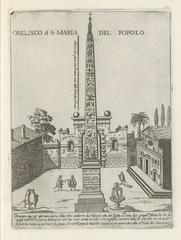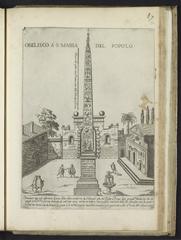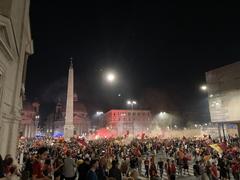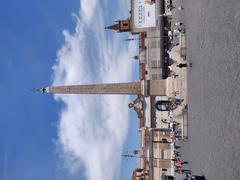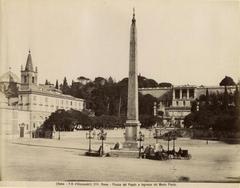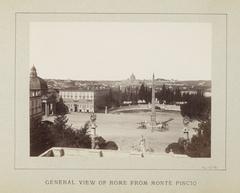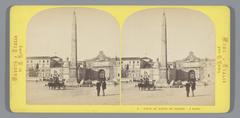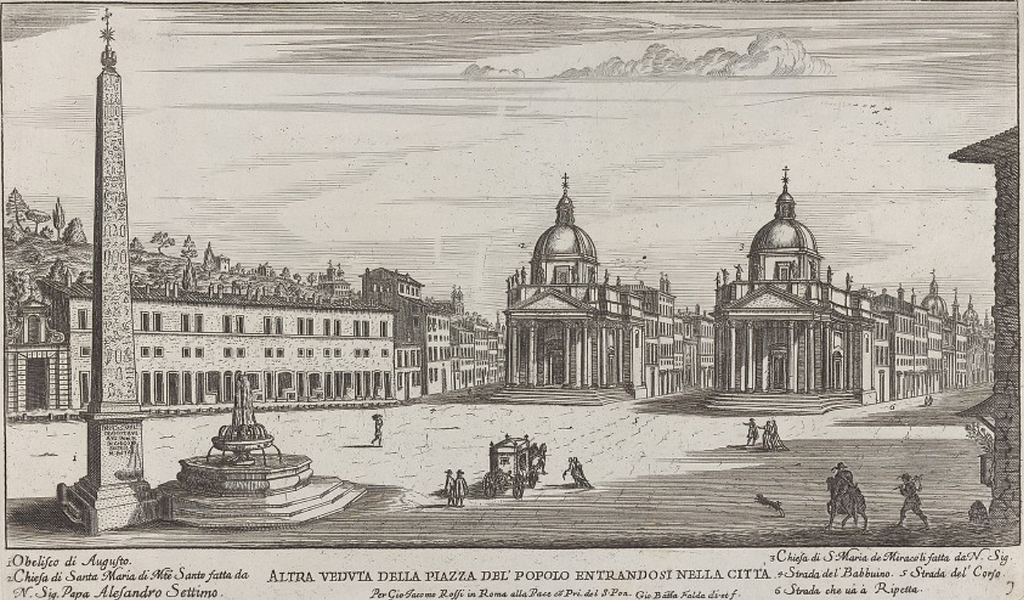
Visiting Hours, Tickets, and Travel Tips for Obelisco Flaminio in Rome
Date: 16/07/2024
Introduction
Nestled in the heart of Rome, the Obelisco Flaminio stands as a monumental testament to the enduring legacy of ancient civilizations and their cultural exchanges. This ancient obelisk, originally commissioned by Pharaoh Seti I and completed by Ramses II around 1300 BCE, was a significant artifact of ancient Egyptian culture, celebrating the divine right and accomplishments of the pharaohs (rome.net). Its journey from the sands of Egypt to its current prominent location in Piazza del Popolo in Rome encapsulates a fascinating narrative of conquest, assimilation, and restoration. Transported to Rome in 10 BCE by Emperor Augustus as a symbol of victory and divine favor, the Obelisco Flaminio was initially erected in the Circus Maximus, serving as a central feature in the largest chariot racing stadium of ancient Rome (ancient.eu). Rediscovered and revived during the Renaissance under Pope Sixtus V, this obelisk was relocated in 1589 to Piazza del Popolo, where it now stands as a centerpiece, contributing to the square’s architectural symmetry and historical ambiance (romeartlover.it). This guide provides a comprehensive overview of the Obelisco Flaminio’s historical significance, practical information for visitors, and insights into its cultural and architectural impact, ensuring a rich and informed experience for those planning to explore this iconic monument.
Table of Contents
- Introduction
- History and Cultural Significance
- Visitor Information
- Preservation Efforts
- FAQ
- Conclusion
History and Cultural Significance
Origins and Ancient Egypt
The Obelisco Flaminio, one of Rome’s most iconic landmarks, has its origins deeply rooted in ancient Egypt. This obelisk was originally commissioned by Pharaoh Seti I, who ruled Egypt from 1290 to 1279 BCE. However, it was his son, Ramses II, who completed the construction. The obelisk was erected in the Temple of the Sun in Heliopolis, a major religious center in ancient Egypt dedicated to the sun god Ra. The obelisk’s inscriptions celebrate the pharaohs’ divine right to rule and their accomplishments, making it a significant artifact of ancient Egyptian culture (rome.net).
Roman Acquisition
The journey of the Obelisco Flaminio from Egypt to Rome is a tale of conquest and cultural assimilation. In 10 BCE, the Roman Emperor Augustus ordered the transportation of the obelisk to Rome as a symbol of his victory over Egypt. This was part of a broader Roman practice of bringing Egyptian obelisks to Rome to demonstrate the empire’s power and the emperor’s divine favor. The obelisk was transported via a specially constructed ship, a feat of engineering that underscored Rome’s advanced capabilities (ancient.eu).
Placement in the Circus Maximus
Upon its arrival in Rome, the Obelisco Flaminio was erected in the Circus Maximus, the largest chariot racing stadium in ancient Rome. The obelisk served not only as a decorative element but also as a monumental marker of the central spine (spina) of the circus. It stood there for several centuries, witnessing countless chariot races and public spectacles that were central to Roman social and political life (britannica.com).
Medieval and Renaissance Periods
During the medieval period, the obelisk fell into obscurity as the Circus Maximus was abandoned and gradually buried under layers of sediment and debris. It wasn’t until the Renaissance, a period marked by a renewed interest in classical antiquity, that the obelisk was rediscovered. Pope Sixtus V, who reigned from 1585 to 1590, played a crucial role in the obelisk’s revival. He ordered its excavation and re-erection as part of his broader urban renewal projects aimed at glorifying the Catholic Church and Rome’s ancient heritage (romeartlover.it).
Relocation to Piazza del Popolo
In 1589, the Obelisco Flaminio was relocated to its current location in Piazza del Popolo, one of Rome’s most famous squares. The relocation was overseen by the architect Domenico Fontana, who was responsible for many of Sixtus V’s urban projects. The obelisk was placed at the center of the square, which was redesigned to enhance its visual impact. This move was part of a broader strategy to create a network of obelisks and fountains that would guide pilgrims and visitors through the city, emphasizing Rome’s historical and spiritual significance (rome.net).
Modern Era and Restoration
In the modern era, the Obelisco Flaminio has undergone several restoration efforts to preserve its structural integrity and historical inscriptions. The most recent restoration was completed in 2013, ensuring that the obelisk remains a prominent and well-preserved symbol of Rome’s rich history. Today, it continues to attract tourists and scholars alike, serving as a tangible link between ancient Egypt, imperial Rome, and the Renaissance (rometourism.com).
Cultural Significance
The Obelisco Flaminio is more than just a historical artifact; it is a symbol of the cultural and political exchanges that have shaped Rome over millennia. Its journey from the sands of Egypt to the heart of Rome encapsulates the city’s ability to absorb and repurpose the cultural symbols of other civilizations. The obelisk’s presence in Piazza del Popolo also highlights the Renaissance popes’ efforts to connect Rome’s ancient past with its Christian present, creating a continuous narrative of power and faith (rome.net).
Architectural and Artistic Impact
The relocation and re-erection of the Obelisco Flaminio had a significant impact on the architectural and artistic landscape of Rome. The obelisk’s presence in Piazza del Popolo influenced the design of the square and its surrounding buildings. The square itself became a model for urban planning, with its symmetrical layout and axial alignment serving as a template for other public spaces in Rome and beyond. The obelisk also inspired numerous artists and architects, who incorporated its form and symbolism into their works (romeartlover.it).
Visitor Information
Best Time to Visit
Piazza del Popolo is accessible year-round, but the best time to visit is during the early morning or late afternoon when the light is ideal for photography, and the square is less crowded. The summer months can be particularly busy, so visiting during the shoulder seasons of spring and fall can provide a more relaxed experience.
Tickets and Visiting Hours
The Obelisco Flaminio itself is free to visit as it stands in a public square. Piazza del Popolo is open 24 hours a day, seven days a week, making it accessible at any time. However, nearby attractions may have specific visiting hours and ticket prices. For example, the Church of Santa Maria del Popolo has particular opening hours and may require an entrance fee for certain parts.
Guided Tours
For those interested in a deeper understanding of the obelisk’s history and significance, guided tours are available. These tours often include other nearby attractions such as the Church of Santa Maria del Popolo, which houses works by Caravaggio and Bernini. Some tours also offer insights into the broader historical context of Rome’s obelisks and their role in the city’s urban development. Recommended tour operators include Walks of Italy and Context Travel.
Accessibility
Piazza del Popolo is easily accessible by public transportation. The nearest metro station is Flaminio (Line A), which is just a short walk from the square. The area is also well-served by buses and trams. For those with mobility issues, the square is relatively flat and wheelchair-friendly, although some of the surrounding streets are cobblestoned.
Nearby Attractions
In addition to the obelisk, Piazza del Popolo is home to several other notable landmarks:
- Santa Maria del Popolo: This church, located at the northeast corner of the piazza, houses works by Caravaggio, Bernini, and Raphael. It is a must-visit for art enthusiasts (Santa Maria del Popolo).
- Pincio Gardens: A short climb up the steps from the piazza leads to the Pincio Gardens, a beautiful park offering stunning views of Rome. It’s an ideal spot for a leisurely stroll or a picnic.
- Via del Corso: This major shopping street starts at Piazza del Popolo and runs south to Piazza Venezia. It’s perfect for those looking to indulge in some retail therapy.
Safety and Etiquette
While Piazza del Popolo is generally safe, it is always advisable to be mindful of your belongings, especially in crowded areas. Pickpocketing can be an issue in tourist hotspots. Additionally, while photography is encouraged, visitors should be respectful of the site and avoid climbing on the obelisk or other monuments.
Preservation Efforts
Conservation Challenges
The Obelisco Flaminio, like many ancient monuments, faces ongoing conservation challenges. Exposure to the elements, pollution, and the wear and tear from millions of visitors all take their toll. The obelisk’s hieroglyphs, in particular, are susceptible to erosion, which can obscure their intricate details and historical significance.
Restoration Projects
Several restoration projects have been undertaken to preserve the obelisk. In the late 20th century, a major conservation effort was launched to clean the obelisk and stabilize its structure. This project involved the use of advanced techniques such as laser cleaning to remove accumulated grime without damaging the stone. Ongoing maintenance is essential to ensure that the obelisk remains a vibrant part of Rome’s cultural heritage.
Public Awareness
Efforts to preserve the obelisk are complemented by initiatives to raise public awareness about its historical and cultural importance. Educational programs, informational plaques, and guided tours all contribute to a greater appreciation of the obelisk and the need to protect it for future generations. By fostering a sense of shared responsibility, these initiatives help ensure that the Obelisco Flaminio continues to inspire and educate visitors from around the world.
FAQ
Q: What are the visiting hours for Obelisco Flaminio? A: The Piazza del Popolo is open 24 hours a day, but visiting during daylight hours is recommended.
Q: Is there an entry fee to see the Obelisco Flaminio? A: No, there is no entry fee as it is located in a public square.
Q: How can I get to Piazza del Popolo? A: The nearest metro station is Flaminio (Line A), and several bus lines also service the area.
Q: Are there guided tours available? A: Yes, guided tours are available and provide detailed insights into the history and significance of the obelisk.
Conclusion
The Obelisco Flaminio stands as a testament to the enduring legacy of ancient Egypt and Rome’s ability to integrate and celebrate the cultural achievements of other civilizations. Its history, from its creation in Heliopolis to its prominent position in Piazza del Popolo, reflects the dynamic and interconnected nature of human history. For anyone visiting Rome, the obelisk is a must-see landmark that offers a profound connection to the past and a deeper understanding of the city’s rich cultural heritage. Don’t miss the chance to explore this remarkable monument and the surrounding historical sites during your visit to Rome. For further details and updates, visitors can explore the official Rome tourism website.
References
- Discover the History and Cultural Significance of Obelisco Flaminio in Rome, 2024, Rome.net rome.net
- Roman Obelisks, 2024, Ancient.eu ancient.eu
- Obelisk in Rome, 2024, Rome Art Lover romeartlover.it
- Piazza del Popolo, 2024, Rome.net rome.net
- Rome Tourism, 2024, Rome Tourism turismoroma.it
- Walks of Italy, 2024, Walks of Italy walksofitaly.com
- Context Travel, 2024, Context Travel contexttravel.com
- Santa Maria del Popolo, 2024, Santa Maria del Popolo santamariadelpopolo.it
- Rosati, 2024, Rosati rosatiroma.it
- Canova, 2024, Canova canovapiazzadelpopolo.com
- Ristorante Ad Hoc, 2024, Ristorante Ad Hoc ristoranteadhoc.com
- Via Margutta, 2024, Romeing romeing.it

